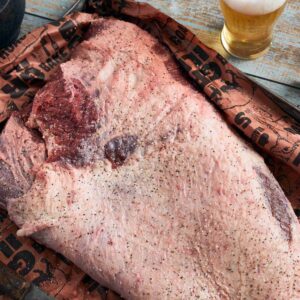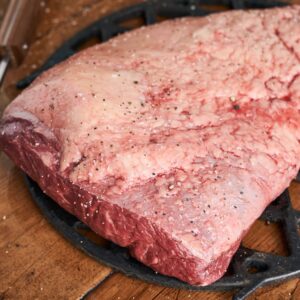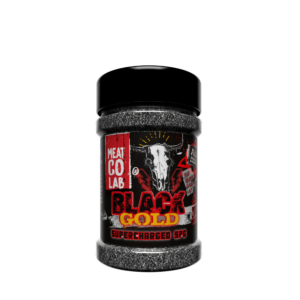
How to cook Jacobs Ladder
- 360 Minutes
- Medium
- Beef
Jacobs Ladder are a perfect choice for cooking low and slow and this recipe from our friends at Smoke and Sear is perfect for the weekend. Low and Slow is perfect if you want an irresistible flavour and fall of the bone texture. This recipe is perfect for a long smoke on the BBQ.
Cooking Method
- Remove your Jacobs ladder from the packaging and remove the silver skin, making sure not to remove the membrane from the bottom of the ribs.
Make a diamond pattern by scoring diagonally along the meat. - Using sea crack or the salt of your choice, dry brine the beef, overnight or 4 hours before, on the top and sides of the beef.
- Using Angus & Oink Dirty cow seasoning, sprinkle all over the top and sides of the rib.
- Add your cider to a small try and place under the cooking grate and heat your BBQ to 200F.
Place your ribs on and cook low and slow for 2 ½ hours or until the ribs reach an internal temperature of 165.
For the best flavour mix together apple cider vinegar, water and bourbon whisky 940/40/20) into a spray bottle and lightly spray the ribs.
Close the lid and cook for a further hour. - After another hour has passed check the ribs and spray again. You should see a retraction of the meat which will expose the bones.
Leave for one hour. - If your ribs haven’t reached an internal temperature of 205F you can wrap them up and place back on the BBQ for another 2-3 hours or until they reach 205F.
Remove from the BBQ once they have reached the internal temperature leave wrapped in a towel and placed in a cooler for 45 minutes before serving.
The Ingredients
- 2-3kg Beef Short Rib/ Jacobs Ladder
- BBQ Rub
- Angus and Oink Dirty Cow Seasoning
- Cider (of your choice)
What to serve with Jacobs Ladder
- Honey roasted carrots
- Creamy garlic mash
- Salad
- Roasted potatoes
- Tenderstem broccoli
- Rich gravy
Frequently Asked Questions
Jacobs Ladder, or beef short ribs, comes from the beef chuck rather than the ribs. They are short ribs that are rich in flavour and typically meatier, containing more layers of muscle and fat compared to other cuts which makes them the perfect choice for slow cooking.
The name "Jacob's Ladder" comes from its ladder-like appearance when several ribs are still attached together.
Beef short ribs contain a lot of connective tissue, which can be tough if not properly broken down during the cooking process. Slow cooking methods such as braising, stewing, or smoking allow the meat to cook low and slow over a longer period of time, which helps to tenderise the tough connective tissues and renders the meat moist, flavourful, and fall-off-the-bone tender.
Whilst it is possible to cook beef short ribs using other methods such as grilling or roasting, slow cooking methods are generally preferred to achieve the best results in terms of tenderness and flavour.



